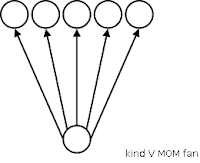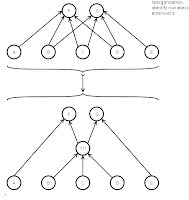 Kind N networks, in the MOM terminology, are such ones of four or more nodes, two predecessors (cf. image: nodes A and B), two successors (nodes C and D), and each of the predecessors connected to each of the successors. That looks like a mixture of an "N" and an "X" character.
Kind N networks, in the MOM terminology, are such ones of four or more nodes, two predecessors (cf. image: nodes A and B), two successors (nodes C and D), and each of the predecessors connected to each of the successors. That looks like a mixture of an "N" and an "X" character.As the X often gets used to indicate something unknown, but here is not anything unknown, that kind of network got called the N network.
 -- Add a pair of successor and predecessor, and it still looks somewhat like that X-N mixture. As it features more but two base and two top points, we call it a pure kind N network: any MOM sub-network that consists of an equal number of predecessor and successor nodes (and wires all the predecessor to the successor nodes) is called a pure kind N network. Thus, the N network, of course, is also a pure kind N network.
-- Add a pair of successor and predecessor, and it still looks somewhat like that X-N mixture. As it features more but two base and two top points, we call it a pure kind N network: any MOM sub-network that consists of an equal number of predecessor and successor nodes (and wires all the predecessor to the successor nodes) is called a pure kind N network. Thus, the N network, of course, is also a pure kind N network.Then, there are chances, a network features more successor nodes but predecessor ones.
 If the number of predecessor nodes is >= 2, that kind of net gets called a kind W network, because of its shape. -- It gets called the W network, if it sports only two predecessor and exactly three successor nodes.
If the number of predecessor nodes is >= 2, that kind of net gets called a kind W network, because of its shape. -- It gets called the W network, if it sports only two predecessor and exactly three successor nodes.  If a graph features only a single predecessor node, it's a kind V fan. Similar to the naming scheme for the W network, a kind V fan gets called the V fan, if its shape matches the letter: If it features a single predecessor and exactly two successor nodes.
If a graph features only a single predecessor node, it's a kind V fan. Similar to the naming scheme for the W network, a kind V fan gets called the V fan, if its shape matches the letter: If it features a single predecessor and exactly two successor nodes.Put upside down, we get a kind M network, the M network, a kind A fan and the A fan, resepectively.
Because kind W/M networks follow the pure kind N network approach by wiring each predecessor with each successor node, all together -- kind W, kind M and pure kind N networks get summarized under the generic "kind N network" label.
So, the efforts done were to detect any kind N networks within a larger MOM network. Why? -- The complete wiring of each predecessor node with each successor node results in a situation,
 that the content of each successor node equals the content of all predecessor nodes together (plus the content of any separate predecessor nodes the successors don't share with their neighbours of that kind N network). The image aside shows it: Nodes F and G share the content of B, C and D. A becomes part of F only, so does E for G. -- That sharing of common predecessor nodes implies two things:
that the content of each successor node equals the content of all predecessor nodes together (plus the content of any separate predecessor nodes the successors don't share with their neighbours of that kind N network). The image aside shows it: Nodes F and G share the content of B, C and D. A becomes part of F only, so does E for G. -- That sharing of common predecessor nodes implies two things: - First, as any MOM node represents the merged content of its predecessor nodes, we could replace the heavy wiring by adding a new node and wire link all predecessor nodes of the kind N network to that newly added node and it to all the successor nodes. That way the number of edges needed to administer could get reduced from a * b to only a + b.
- Second, as now it might be obvious, that wiring of all the predecessor nodes to each of the successor nodes was nothing different but an implication. A not explied (?)/explicited (?) notion. By adding the node, we make it explicit.
Now, part of it was rewritten and all of it documented. Now that sub-framework for kind N net detection needs to get spread into separate class files and put into a sub-directory or sub-directory hierarchy.
Updates: none so far

No comments:
Post a Comment